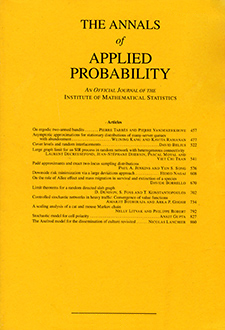Abstract
Let $X=(X_{t})_{t\ge0}$ be a transient diffusion process in $(0,\infty)$ with the diffusion coefficient $\sigma>0$ and the scale function $L$ such that $X_{t}\rightarrow\infty$ as $t\rightarrow\infty$, let $I_{t}$ denote its running minimum for $t\ge0$, and let $\theta$ denote the time of its ultimate minimum $I_{\infty}$. Setting $c(i,x)=1-2L(x)/L(i)$ we show that the stopping time
\[\tau_{*}=\inf\{t\ge0\vert X_{t}\ge f_{*}(I_{t})\}\]
minimizes $\mathsf{E}(\vert\theta-\tau\vert-\theta)$ over all stopping times $\tau$ of $X$ (with finite mean) where the optimal boundary $f_{*}$ can be characterized as the minimal solution to
\[f'(i)=-\frac{\sigma^{2}(f(i))L'(f(i))}{c(i,f(i))[L(f(i))-L(i)]}\int_{i}^{f(i)}\frac{c_{i}'(i,y)[L(y)-L(i)]}{\sigma^{2}(y)L'(y)}\,dy\]
staying strictly above the curve $h(i)=L^{-1}(L(i)/2)$ for $i>0$. In particular, when $X$ is the radial part of three-dimensional Brownian motion, we find that
\[\tau_{*}=\inf\biggl\{t\ge0\Big\vert\frac{X_{t}-I_{t}}{I_{t}}\ge\varphi\biggr\},\]
where $\varphi=(1+\sqrt{5})/2=1.61\ldots$ is the golden ratio. The derived results are applied to problems of optimal trading in the presence of bubbles where we show that the golden ratio rule offers a rigorous optimality argument for the choice of the well-known golden retracement in technical analysis of asset prices.
Citation
Kristoffer Glover. Hardy Hulley. Goran Peskir. "Three-dimensional Brownian motion and the golden ratio rule." Ann. Appl. Probab. 23 (3) 895 - 922, June 2013. https://doi.org/10.1214/12-AAP859
Information





